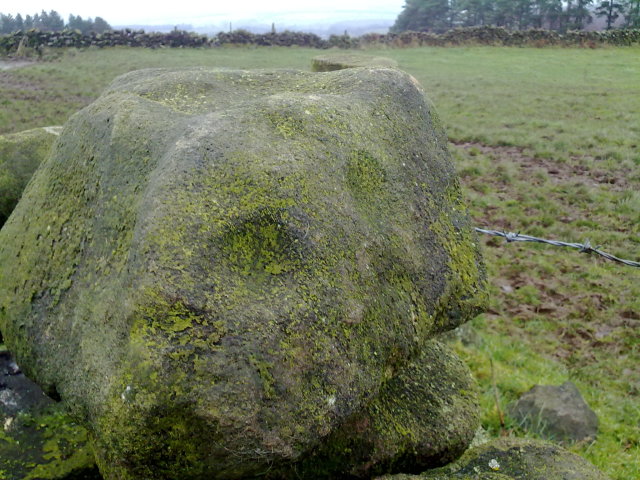Cup-Marked Stone: OS Grid Reference – SK 2254 6284
Taking the roughly north-south road betwixt the village of Elton and the town of Youlgrave, rising up to see the great rock outcrop of Robin Hood’s Stride, park-up by the roadside and walk down the path across the fields to the Nine Stone Close stone circle. Once at the circle, the walling closest to the stones runs along a bit (north), then downhill. Follow it. About 25 yards before hitting more walling that crosses your path, there’s a break in the wall to a field immediately left. Just below this gate opening, in the same wall, a few yards down, look for the stone!
Archaeology & History
This small carved stone, typical of the size you get in drystone walls all over the country, was discovered for the first time on November 29, 2009, by Geoff Watson, during an ambling foray exploring the megalithic sites in and around the Birchover district. Not quite sure how his nose picked this little fella out, but once seen (and eyes adjusted!) it was obviously a portable cup-marked stone. Though what, we first wondered, was it doing in the walling here?
Similar in size and form to the Bent Head cup-marked stone found in drystone walling near Todmorden, West Yorkshire, the proximity of the Nine Stone Close megalithic ring further up the slope from this example illustrated that prehistoric man found this location of some importance; but as the cup-markings — two definites, perhaps a third — had been etched onto a small portable rock, typical of those found in prehistoric tombs, we wondered whether or not a prehistoric grave had once stood close by. Thankfully, a persual of Barry Marsden’s (1977) catalogue later proved fruitful. For in the adjacent field below where this carved stone sits in its wall, at SK 2255 6286, there’s a scattered mass of loose rocks and smaller stones (akin to the one here with its cup-markings), which Marsden listed as a prehistoric tomb. It seems probable that this cup-marked ‘portable’ originally came from this much denuded burial spot.
Likelihood is — there’ll be more of ’em hiding in walling and elsewhere hereby…
NB – Please note – the images we took of the stone aint too good as the sky was grey, cloudy and overcast all day. We await a better visit on a finer day, when conditions allow for better images. As we all know, gerrin’ decent photos of cup-markings and their ilk can be a pain in the arse even on the best of days!
References:
- Heathcote, J. Percy, Birchover – Its Prehistoric and Druidical Remains, Wilfrid Edwards: Chesterfield 1947. (see MegaDread’s comment, below)
- Marsden, Barry, The Burial Mounds of Derbyshire, privately printed: Bingley 1977.
© Paul Bennett, The Northern Antiquarian

“Though what, we first wondered, was it doing in the walling here?”
That was you mate, i wouldn’t have given the cup stone / cairn relationship a thought, novice that i am, wouldn’t have even been there if it wasn’t for you as i mentioned, i’d have been off Congleton way for my first visit to see the Bridestones remains.
Geoff.
Hi Paul, just reading “Birchover, it’s prehistoric and druidical remains” where i found this little reference in relation to a cairn in the vicinity of the circle.
“In 1877 Llewellyn Jewitt and canon Greenwell, the famous author of British barrows, together with “a rankless troop of rank and file” excavated a large barrow in the field facing Hartle moor farm, but found only bones”.
“Two other neighbouring mounds were tested but proved to be natural bosses”.
That’s all it says but takes the history of the cairn, if indeed it’s the same one, back some way.
Geoff.
I’ve been to Robin Hoods Stride today as I go a lot I can’t believe no one has picked up on the dozens of cup marks on the top of the stride it’s self there are so many which are clearly cup marks!! Although I’m by no means an expert but on the other hand I’ve visited 90% of the prehistoric sites in Derbyshire and a lot up and down the country!! I’d put a large amount of money that they are especially as Rowter Rocks is only around a mile away which has lots of rock art and cup marks!!